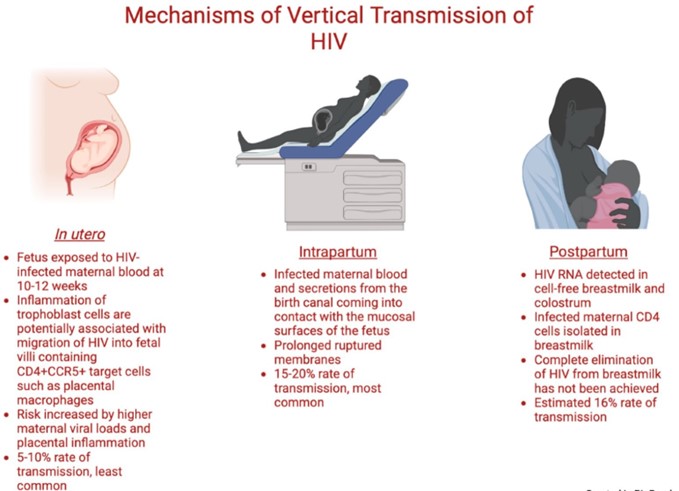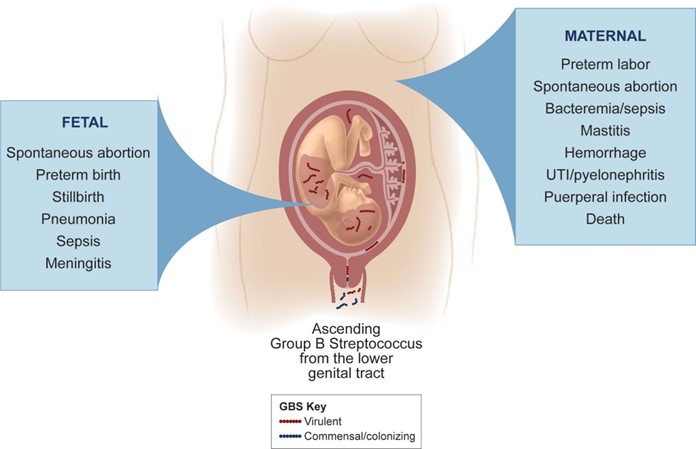A nurse on the labor and delivery unit is planning care for a client who has human immunodeficiency virus (HIV). Which of the following is an appropriate action for the nurse to take following the birth of the newborn?
Cleanse the newborn immediately after delivery.
Initiate contact precautions for the newborn.
Administer intravenous antibiotics to the newborn.
Encourage the mother to breastfeed her newborn.
The Correct Answer is A
A newborn who is exposed to HIV perinatally should be bathed and cleansed of maternal secretions as soon as possible after birth to reduce the risk of HIV transmission through the skin or mucous membranes¹². The newborn should also receive antiretroviral prophylaxis within six hours of delivery, preferably within two hours¹². The type and duration of prophylaxis depend on the maternal and infant factors that influence the risk of HIV transmission, such as maternal viral load, antiretroviral therapy, mode of delivery, and infant gestational age¹²³. The newborn should also undergo HIV testing at birth, at 14 to 21 days of age, at one to two months of age, and at four to six months of age¹².
The other options are incorrect because:
b) Initiating contact precautions for the newborn is not necessary or recommended. Contact precautions are used to prevent the spread of infections that are transmited by direct or indirect contact with the patient or the patient's environment. HIV is not transmited by casual contact, and standard precautions are sufficient to prevent exposure to blood or body fluids that may contain HIV¹².
c) Administering intravenous antibiotics to the newborn is not indicated for HIV prevention. Antibiotics are used to treat bacterial infections, not viral infections like HIV. Antibiotics may be given to the newborn for other reasons, such as suspected sepsis or chorioamnionitis, but they do not affect the risk of HIV transmission¹².
d) Encouraging the mother to breastfeed her newborn is contraindicated for HIV prevention. Breastfeeding can transmit HIV from the mother to the infant through breast milk, especially if the mother has a high viral load, mastitis, cracked nipples, or oral lesions in the infant. In resource-limited settings where formula feeding may not be feasible or safe, breastfeeding with maternal or infant antiretroviral therapy may be considered, but in developed countries where safe alternatives are available, breastfeeding is not recommended for mothers with HIV infection¹².

Nursing Test Bank
Naxlex Comprehensive Predictor Exams
Related Questions
Correct Answer is C
Explanation
Group B Streptococcus β-hemolytic (GBS) is a type of bacteria that can cause serious infections in newborns, such as sepsis, pneumonia, and meningitis. GBS can be transmitted from the mother to the baby during labor and delivery if the mother is colonized with GBS in her vagina or rectum¹.
To prevent GBS infection in newborns, pregnant women who test positive for GBS or have risk factors for GBS should receive intravenous (IV) antibiotics during labor. The antibiotics can reduce the amount of GBS bacteria in the mother's body and lower the chance of passing them to the baby¹².
The recommended antibiotic for GBS prophylaxis is penicillin, which is safe and effective for most women. However, some women may be allergic to penicillin and need an alternative antibiotic. Ampicillin is one of the alternative antibiotics that can be used for GBS prophylaxis in women who have a mild allergy to penicillin (such as rash or itching). Ampicillin is also a type of penicillin, but it has a slightly different structure and may not cause an allergic reaction in some people²³.
Therefore, the nurse should plan to administer ampicillin to the client who tested positive for GBS and has a mild allergy to penicillin. The nurse should also monitor the client for any signs of anaphylaxis (a severe allergic reaction) and have epinephrine ready in case of emergency²³.
The other options are not medications that the nurse should administer to the client:
- a) Cefotetan is another alternative antibiotic that can be used for GBS prophylaxis in women who have a severe allergy to penicillin (such as anaphylaxis or angioedema). However, it is not indicated for women who have a mild allergy to penicillin, as it may still cause cross-reactivity and an allergic reaction²³.
- b) Fluconazole is an antifungal medication that is used to treat fungal infections, such as candidiasis (thrush) or cryptococcal meningitis. It is not effective against bacterial infections, such as GBS, and it is not indicated for GBS prophylaxis⁴.
- d) Doxycycline is an antibiotic that is used to treat bacterial infections, such as chlamydia, gonorrhea, or Lyme disease. It is not effective against GBS and it is not indicated for GBS prophylaxis. Moreover, doxycycline is contraindicated in pregnancy, as it can cause harm to the fetus, such as tooth discoloration or bone growth problems.

Correct Answer is C
Explanation
Phototherapy is a treatment method used to reduce high levels of bilirubin in the blood of a newborn with jaundice. During phototherapy, the newborn is exposed to special lights that help break down the bilirubin and allow it to be eliminated from the body. It is important to protect the newborn's eyes during phototherapy.
Option a) Giving the newborn 1 oz of glucose water every 4 hours is not necessary for phototherapy. The primary goal of phototherapy is to treat jaundice, and providing glucose water is not directly related to this treatment.
Option b)Applying a thin layer of lotion to the newborn's skin every 8 hours is not necessary during phototherapy. In fact, it is generally recommended to avoid applying lotions or oils to the skin during phototherapy as they can interfere with the effectiveness of the treatment.
Option c) Ensuring the newborn's eyes are closed beneath the shield is essential during phototherapy. The eyes are particularly sensitive to the light used in phototherapy, and exposure to the light can potentially damage the eyes. Therefore, the newborn's eyes should be protected with a shield or eye patches to prevent direct exposure to the light.
Option d) Dressing the newborn in a thin layer of clothing during therapy is appropriate. The newborn should be dressed in a way that allows as much of their skin as possible to be exposed to the phototherapy lights. This usually involves removing unnecessary clothing and covering the genital area with a diaper, while the rest of the body is exposed to the light.
Whether you are a student looking to ace your exams or a practicing nurse seeking to enhance your expertise , our nursing education contents will empower you with the confidence and competence to make a difference in the lives of patients and become a respected leader in the healthcare field.
Visit Naxlex, invest in your future and unlock endless possibilities with our unparalleled nursing education contents today
Report Wrong Answer on the Current Question
Do you disagree with the answer? If yes, what is your expected answer? Explain.
Kindly be descriptive with the issue you are facing.
